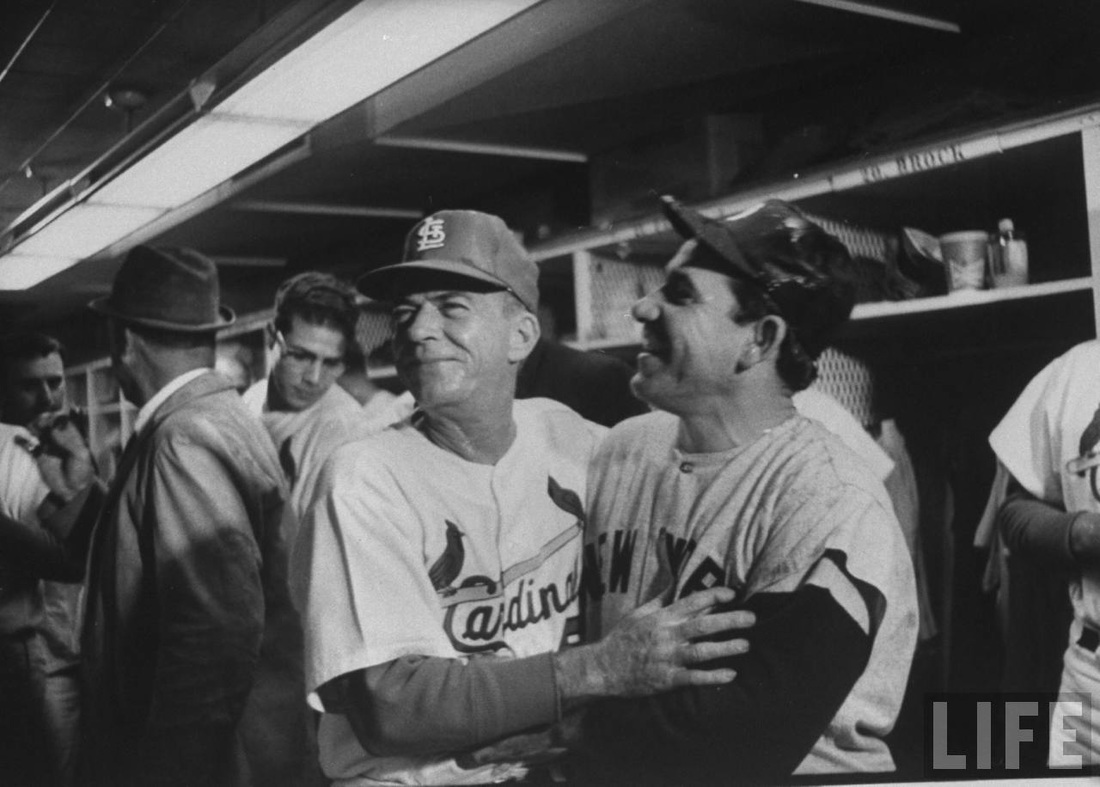 Photo Credit- www.flickriver.com
Photo Credit- www.flickriver.com One of the players he would get to manage would become his replacement as Cardinals manager after the 1964 season. Red Schoendienst turns 93 today and the Hall of Fame second baseman has the distinction of having five World Series rings. Schoendienst won his first as a player with the Cardinals in 1946, then with the Milwaukee Braves in 1957. The third World Series Championship Schoendienst would be part of was in 1964. The final month of the 1964 season would go down as one of the most interesting in the history of the sport.
Keane was the manager of the Cardinals that season, the team's first in 18 years without winning a National League Pennant. It was also the team's first in years without their franchise icon Stan Musial, who retired following the 1963 season. Outside of the 1945 season that Musial did not play in due to his service in the US Navy, the Cardinals were losing their franchise player for the past 23 seasons. With Musial retiring, it meant saying good-bye to the last remaining player to appear in each of the Cardinals last four World Series (1942-1944, 1946).
Though the San Francisco Giants and Los Angeles Dodgers were the cream of the National League, the Cincinnati Reds were expected to give them some competition. The Cardinals had finished in second place the season before so it was expected to be a four team race. However, the surprise of the National League came from the city of Philadelphia, where the Phillies seemed to be a team of destiny. An underwhelming offensive team, the Phillies relied on strong starting pitching and small ball- a trait of manager Gene Mauch. The Phillies did have the MVP of the All Star Game in Johnny Callison, known for his walk-off three-run home run that won it for the NL at Shea Stadium that season. Third baseman Richie "Dick" Allen was on his way to winning the NL Rookie of the Year Award for the season. The Phillies led the National League by 6 1/2 games with 12 games to play on the 20th of September.
Meanwhile, it St Louis, it was the Cardinals who were looking to go in a different direction. Branch Rickey had been hired as a consultant to owner August Busch. His recommendations were to replace just about the entire front office, led by General Manager Bing Devine. Though nothing was official, it was expected that Keane himself was going to be replaced after the season. New GM Bob Howsam was in contact with Dodger third base coach Leo Durocher about the possibility of managing the team.
Though no team should ever give up, it was obvious the Cardinals were planning for 1965. Looking at their second straight winning season and second place finish, the organization needed to figure out how to take their game to the next level. They did add outfielder Lou Brock from the Cubs and he responded by hitting .348 the rest of the way. Bob Gibson gave them an ace that could compete with anybody's number one pitcher. Even so, if it was not for the Phillies epic collapse, the Cardinals may have been in for some dramatic changes going into the next season.
The Phillies would lose their next ten games, including the last three to the Cardinals. This put St Louis in first place with three games to go. Though they lost the next two games against the pitiful New York Mets, the Cardinals managed to clinch the pennant on the last game of the season. The Cardinals came into the World Series as underdogs against the New York Yankees. The series went seven games even though the Cardinals had lost their last two home games. The Cardinals won games four and five in New York before losing game six in St Louis. Gibson out pitched Mel Stottlemyre as the Cardinals took their seventh World Series Championship 7-5, winning the series four games to three.
In one of the most bizarre press conferences the game has ever seen, Keane would announce his resignation after the World Series victory. He handed Howsam over a letter he had written while the season was going on, long before the Cardinals won the Pennant and the World Series. In New York, first year manager and baseball icon Yogi Berra was fired after just one season- one in which he led the Yankees to the World Series. His replacement... Johnny Keane, hired just after he announced his resignation from the Cardinals. Schoendienst was named Cardinals manager for the 1965 season after serving as one of Keane's coaches in 1964.
Keane never got much out of the Yankees in 1965. His distant demeanor did not seem to work well with the players and the Yankees finished in 6th place in 1965, well off the pace of the first place Minnesota Twins. After a 4-16 start in 1966, Keane was fired by GM Ralph Houk, who would take over as manager himself. While Keane took a lot of the heat for the Yankees performance, it is well understood that the Yankees were not the same team that had owned baseball for the past 20 seasons. The Cardinals, however, sustained some success winning the World Series in 1967 over the Boston Red Sox and the National League Pennant in 1968, dropping a seven game World Series to the Detroit Tigers. Ironically, the Cardinals had by that time acquired outfielder Roger Maris from the Yankees, a team that was headed in the opposite direction.
Keane would not be around to see the Cardinals win another World Series. Sadly, Johnny Keane died on January 6, 1967 of a heart attack at the age of 55. Just a month prior to his death, he had accepted a scouting position with the California Angels. In Jim Bouton's book, "I managed good but boy did they play bad," Jim claims that the pressure of winning in New York and the expectation to sustain success as the manager of the Yankees could have led to Keane's death.
Johnny Keane remains an interesting figure and should be given credit for his place in returning the Cardinals to prominence. During his four seasons in St Louis, Keane compiled a 317-247 record as manager and never had a losing season. The Cardinals had previous suffered through losing seasons in five of the past seven years. Keane had a rapport with a lot of the players that had come through the system because of his time in the organization as a manager. In hindsight, he probably should have stayed in St Louis. It is understood that the Cardinals were going through a change in front office and there was a chance that Keane's time was numbered. He certainly left his comfort zone to enter his danger zone. That is the best way to describe Johnny Keane's six seasons as a big league manager.

 RSS Feed
RSS Feed
